CES 2012: new ultrabooks, tablet computers and the first real smartphone with the Intel Atom inside
Today (more precisely, already strongly yesterday), the largest IT exhibition, the Consumer Electronics Show, better known as CES, began its work in Vegas. The flow of information that has fallen upon its participants and the people who follow the exhibition from home, on the screens of their computers and tablets, is truly enormous. Moreover, even all the news of Intel will not fit in one post - in order to avoid informational indigestion. Therefore, instead of trying to grasp the immense, I suggest you take a short tour of the Intel stand, looking at the new items presented through the eyes of the ordinary ... well, almost an ordinary visitor.
Intel's booth this year is big - probably one of the biggest on the whole CES. You go to him, and his eyes run, you do not know where to start. A fun machine will help you to collect your thoughts - the LEGO Digital Box that works is well known on which brand of processors. The car demonstrates the use of the so-called "augmented reality" for practical purposes - you can bring a box with a LEGO designer to the camera, and its entire assembly will immediately appear on the screen. Moreover, the picture will be alive - toy soldiers run over it, dragons fly in, etc. It looks very cool, and in a real store it will really help moms and dads.

')

But, of course, LEGO is not the main character of CES according to Intel. If last year the company's booth narrated almost all its forms, this time everything revolves around ultrabooks. They show themselves how they can protect themselves from various malicious programs and protect the owner’s information, how to have fun with them and how well they work in conjunction with a home NAS, forming a real personal digital cloud. What is nice, many of the models on display by Acer, Asus, Lenovo, HP, Toshiba and other manufacturers are already sold in stores. As for the second (or, rather, one and a half) generation, it should be expected in the spring and, most likely, most announcements will be made during the Computex exhibition in Taiwan.


Muli Eden, who spoke at CES today, said that the Ivy Bridge platform will gain support for NFC, which, presumably, in thin ultrabooks with a very limited set of physical ports and connectors will be particularly useful. The “legal” diagonal of the screens of mobile computers that meet the requirements for ultrabooks is also increasing: now 14-inch and 15-inch will be added to the 11.6-inch and 13-inch versions. By the way, some manufacturers have already shown these "big small" computers and promised to launch them for sale in the coming months.
Next to the ultrabooks modestly hid the tablet computer. It looks and works like a completely ordinary "tablet" on Android 3.2. But inside it has a 32-nanometer Atom (Medfield), which easily reproduces 1080p video and has a good graphics core.

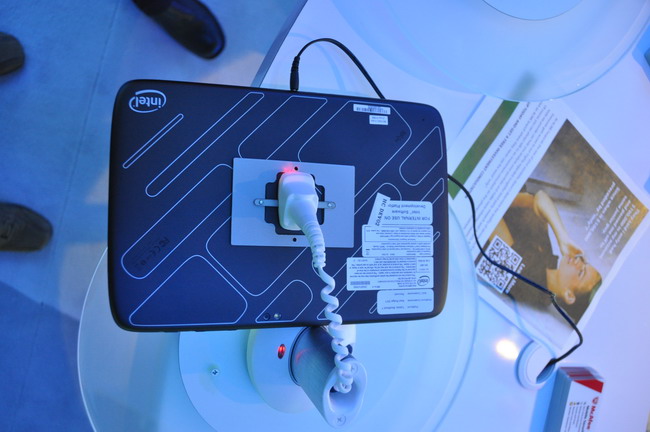
Of course, there are no coolers inside, but they would not fit into such a thin case. Under load, it slightly heats up part of the rear cover in its right side. But just a little bit. But in general, this is a normal tablet computer on Android, which only works faster than usual (in the popular Caffeine 3 test, it is about 20% ahead of the closest rival from the rival camp).
Go ahead and, lo and behold, SMARTPHONE! This smartphone on the Intel Atom Z2460 with a frequency of 1.6 GHz! Moreover, despite the status of the prototype, it looks like it will be on the counter tomorrow. Thin, neatly assembled, with a great screen - everything is as it should. I was not lazy, I put Angry Birds game and AccuWeather weather informant on the bench sample. And it all worked!
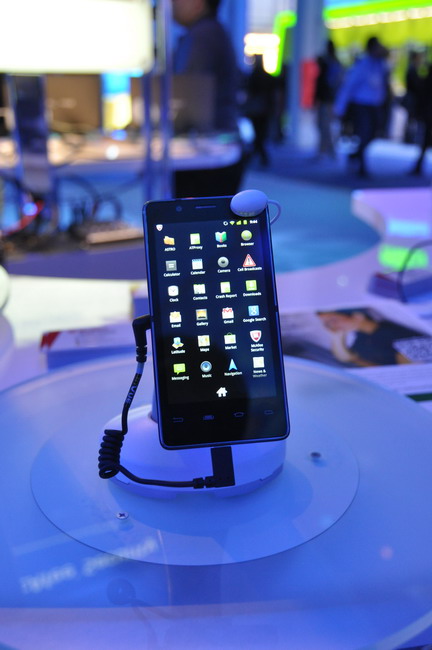
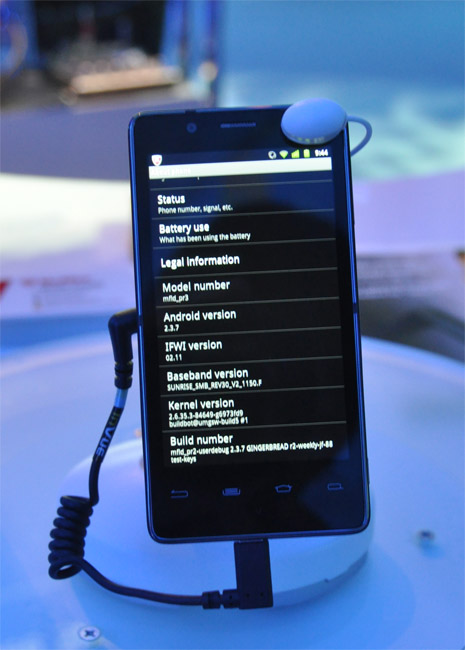

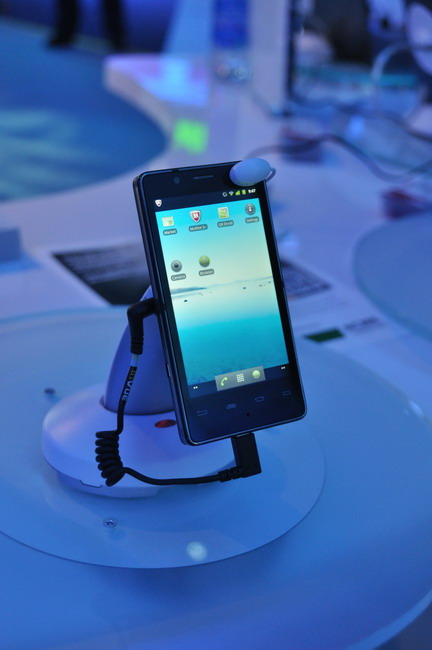
Characteristics of the smartphone can be found in the peep slide.
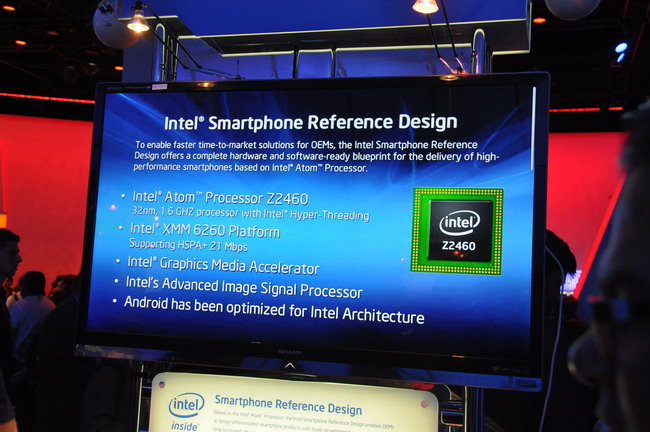
Everyone, of course, is interested in - and what about the time of autonomous work? There is a slide in this case.
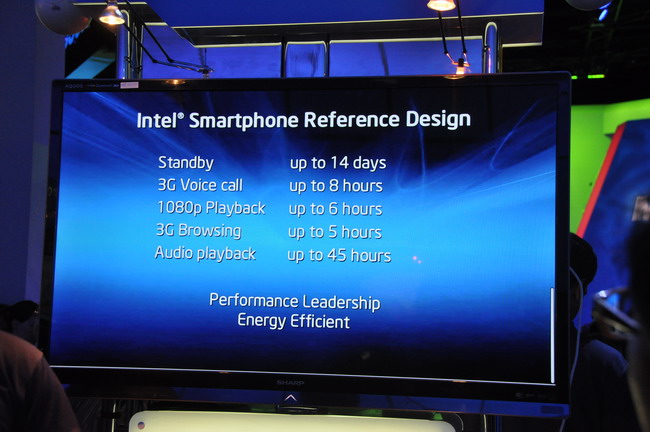
As you can see, the indicators are at the level of dual-core smartphones with a more traditional architecture for this type of devices. Probably, for a real fight you need to be not “not worse”, but much better. And yet I want to say hello to skeptics right now, who said that x86 will never be written in smartphones. As you can see - it is completely prescribed. And today, Lenovo announced the imminent start of mass production of “google phones” on the Intel Atom.
At this point we don’t even put a full stop - a comma. The exhibition has just begun, and it will still present many surprises. I will try to miss as few of them as possible.
Intel's booth this year is big - probably one of the biggest on the whole CES. You go to him, and his eyes run, you do not know where to start. A fun machine will help you to collect your thoughts - the LEGO Digital Box that works is well known on which brand of processors. The car demonstrates the use of the so-called "augmented reality" for practical purposes - you can bring a box with a LEGO designer to the camera, and its entire assembly will immediately appear on the screen. Moreover, the picture will be alive - toy soldiers run over it, dragons fly in, etc. It looks very cool, and in a real store it will really help moms and dads.

')

But, of course, LEGO is not the main character of CES according to Intel. If last year the company's booth narrated almost all its forms, this time everything revolves around ultrabooks. They show themselves how they can protect themselves from various malicious programs and protect the owner’s information, how to have fun with them and how well they work in conjunction with a home NAS, forming a real personal digital cloud. What is nice, many of the models on display by Acer, Asus, Lenovo, HP, Toshiba and other manufacturers are already sold in stores. As for the second (or, rather, one and a half) generation, it should be expected in the spring and, most likely, most announcements will be made during the Computex exhibition in Taiwan.


Muli Eden, who spoke at CES today, said that the Ivy Bridge platform will gain support for NFC, which, presumably, in thin ultrabooks with a very limited set of physical ports and connectors will be particularly useful. The “legal” diagonal of the screens of mobile computers that meet the requirements for ultrabooks is also increasing: now 14-inch and 15-inch will be added to the 11.6-inch and 13-inch versions. By the way, some manufacturers have already shown these "big small" computers and promised to launch them for sale in the coming months.
Next to the ultrabooks modestly hid the tablet computer. It looks and works like a completely ordinary "tablet" on Android 3.2. But inside it has a 32-nanometer Atom (Medfield), which easily reproduces 1080p video and has a good graphics core.


Of course, there are no coolers inside, but they would not fit into such a thin case. Under load, it slightly heats up part of the rear cover in its right side. But just a little bit. But in general, this is a normal tablet computer on Android, which only works faster than usual (in the popular Caffeine 3 test, it is about 20% ahead of the closest rival from the rival camp).
Go ahead and, lo and behold, SMARTPHONE! This smartphone on the Intel Atom Z2460 with a frequency of 1.6 GHz! Moreover, despite the status of the prototype, it looks like it will be on the counter tomorrow. Thin, neatly assembled, with a great screen - everything is as it should. I was not lazy, I put Angry Birds game and AccuWeather weather informant on the bench sample. And it all worked!




Characteristics of the smartphone can be found in the peep slide.

Everyone, of course, is interested in - and what about the time of autonomous work? There is a slide in this case.

As you can see, the indicators are at the level of dual-core smartphones with a more traditional architecture for this type of devices. Probably, for a real fight you need to be not “not worse”, but much better. And yet I want to say hello to skeptics right now, who said that x86 will never be written in smartphones. As you can see - it is completely prescribed. And today, Lenovo announced the imminent start of mass production of “google phones” on the Intel Atom.
At this point we don’t even put a full stop - a comma. The exhibition has just begun, and it will still present many surprises. I will try to miss as few of them as possible.
Source: https://habr.com/ru/post/136039/
All Articles